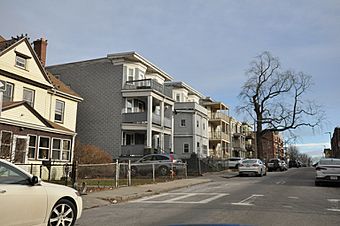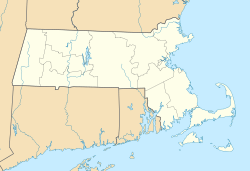Lawrence Avenue Historic District facts for kids
Quick facts for kids |
|
|
Lawrence Avenue Historic District
|
|
 |
|
| Location | Blue Hill Ave., Lawrence Ave., Coleus Park, Magnolia St., and Intervale St., Boston, Massachusetts |
|---|---|
| Area | 14.6 acres (5.9 ha) |
| Built | 1885-1920 |
| Architect | Multiple |
| Architectural style | Queen Anne; Classical Revival; Colonial Revival |
| NRHP reference No. | 100006127 |
| Added to NRHP | February 11, 2021 |
The Lawrence Avenue Historic District is a special area in Boston, Massachusetts. It's located in the Dorchester neighborhood. This district is like a time capsule, showing how people lived in the late 1800s and early 1900s.
It's known for its beautiful old homes and buildings. Many of these buildings show off styles like Queen Anne and Colonial Revival. The district was added to the National Register of Historic Places in 2021. This means it's an important place to protect and remember.
Contents
What is the Lawrence Avenue Historic District?
A historic district is a special part of a town or city. It has buildings, places, or objects that are important because of their history or architecture. The Lawrence Avenue Historic District is a small neighborhood. It's mostly made up of homes.
It's centered around Lawrence Avenue. This street runs from Blue Hill Avenue to Magnolia Street. The area is a great example of how neighborhoods grew in Boston a long time ago.
What Does the Area Look Like?
Lawrence Avenue is mostly lined with homes. You'll see different kinds of buildings here. There are apartment buildings made of brick and stone. There are also single and multi-family homes made of wood.
The area also includes the Martin Luther King Jr. School. This school was built in the 1930s. It has a cool design style called Art Deco. This style was popular for buildings back then.
How Did Lawrence Avenue Grow?
A long time ago, before the late 1800s, this area was mostly large country estates. These were big properties owned by rich families. But then, streetcars became popular. Streetcars were like early public buses that ran on tracks.
With streetcars, it became easier to travel around the city. So, the large estates were sold. They were divided into smaller plots of land. This allowed more homes to be built closer together.
Development on Lawrence Avenue started around 1885. Two developers, a father and son both named William Phipps, built many of the early homes. At first, most of the homes were for single families. Some were designed by an architect named John Roulstone Hall.
A Changing Neighborhood
In the 1910s, the neighborhood began to change. Many Jewish families moved to the area. They came from other parts of Boston and nearby Chelsea. This led to the building of more apartment blocks. These new buildings helped house the growing population.
The Lawrence Avenue Historic District tells a story. It shows how Boston grew and changed over time. It also shows how different groups of people helped shape the city's neighborhoods.



